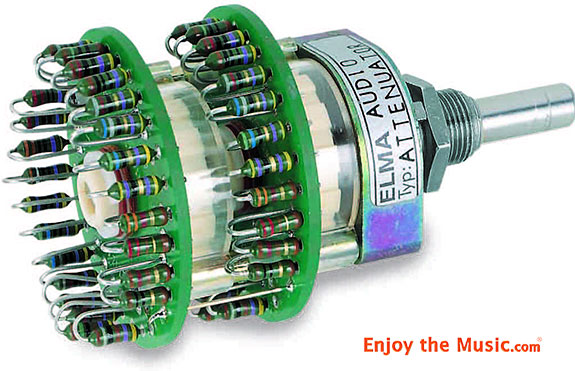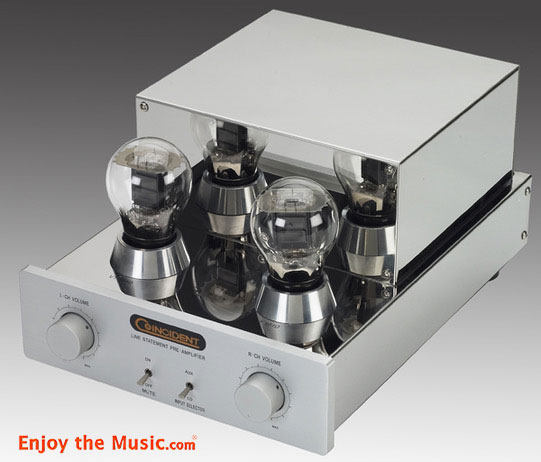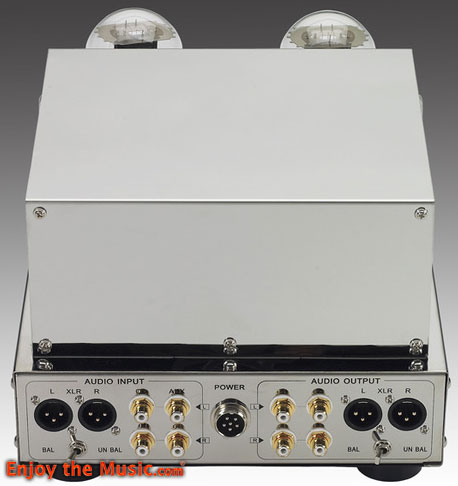
April 2018
Passive Versus Active Preamplifiers
Article By Israel Blume
President, Coincident Speaker Technology

Source:
enjoythemusic.com
Passive Preamplifier
In essence is merely a volume control designed to attenuate the signal going from the source (usually a CD player)
to the amplifier. Since it is passive, it has no inherent gain because it has no active components (tubes or transistors)
in the signal path.
The quality (sonic purity) will be largely dependent on the volume potentiometer used. The finest discrete resistor pots will sound
more accurate than a variable one, for example, since the signal travels through only one resistor at any given setting
and is therefore not dependent on volume position as is the case with a variable pot. Many believe that transformer volume controls can be superior to
even the best discrete resistor pots, since the TVC is inherently passive while the latter still requires the audio signal to traverse a resistor.
The TVC is more costly to properly implement since the best transformers are very expensive.

Slagle Autoformer Volume Control Modules
Type, length and quality of the internal wire will also affect the sound as will the connectors being used.
The inclusion of a selector switch will compromise the ultimate transparency of the sound to a greater or
lesser degree compared to a passive eschewing this switch.
Active Preamplifier
Not only controls the volume of the source component but since it uses active devices (tubes or transistors) in the signal path it has gain.
The active preamp inherently has many components in the signal path compared to a passive. It uses all the components of the passive with
the addition of a power supply, capacitors, resistors, gain devices, and means by which all these parts are connected.
Logic would seem to dictate that the active preamp must adulterate the signal to a far greater degree than the passive by virtue of all those additional components.
Further, since the active has the additional disadvantage of requiring a power source, tubes or transistors it must not only impose far greater noise, it is also more
costly and inconvenient to use. Why would anyone want to use the active in a system? Theoretically, it would seem nonsensical to use anything but a passive preamplifier.

Nelson Pass First Watt B1 Buffer Preamplifier
The Imposition Of The Real World
Passive Preamplifier
While it is inherently simpler in design with no active components in the signal path, it is highly susceptible to component interaction. The affects of the IC cable
(impedance, capacitance and resistance), the source resistance which is the combination of the potentiometer and the actual source and the input impedance of the
amplifier are all critically important in potentially altering the audio signal from source to the ultimate sound being heard.

The length of the cables between the source and passive and then to the amplifier must be strictly attended to. Too long a cable and roll offs at both
frequency extremes will occur. Impedances between the volume control and the input impedance of the amplifier must be compatible in order to avoid sonic degradation.
Furthermore, since a passive has no gain, the output voltage of the source component must be sufficient and the amplifier and the speakers need to be of high sensitivity
or not enough ultimate volume can be achieved.
The purest, simplest but admittedly most inconvenient method of passive attenuation is to have discrete resistor pots installed at the amplifier input. This method avoids
the extra cable interaction and achieves the desired amplifier input impedance.
To summarize, in order for a passive preamp to work properly the following conditions must be met:
- Source component must have sufficient output voltages;
- Short, low capacitance cables must be used between the source to the passive and from passive to the amplifier;
- Output impedance of the passive's volume pot should be low (less than 25kOhms) while the input impedance of the amplifier should be significantly higher (100kOhms);
- Amplifier's input sensitivity should be high (minimum of 0.75v for full output).
- Speakers should be high sensitivity (minimum of 90dB/W/m).
If even one of the above conditions is not adhered to, passives will offer highly compromised sonics.
However, when all of the above conditions are met, there are very few active preamps on the market that will yield better sound overall. For an active to provide superior sound,
will require an amazing unit designed and executed to the highest level. (translation- it will not be cheap- but do not confuse excessive price with high performance- however high performance will be expensive).
Active Preamplifiers
Due to the use of a myriad of components in the signal path, most active preamps severely color the sound. The signal entering them rarely resembles the sound exiting them. Theoretically, an active preamp should
emulate a straight wire with gain. It should be as pure and transparent as the finest passives in an optimized system yet offer the benefits of gain and non-susceptibility to component or cable interaction. This task would
seem impossible to fully achieve and arguably no active preamp currently available has been completely successful in its accomplishment. The realistic goal of an active preamp is to provide sound with all the
advantages inherent in the design with drawbacks that are so minor as to wither into insignificance when viewed in its totality. Achieving this objective requires the following:
- The finest passive and active components available connected with the shortest signal paths possible all being hardwired;
- A separate power supply that is impervious to voltage fluctuation or current demands;
- The finest form of signal attenuation which means transformer coupling;
- The lowest amount and purest gain devices which involves transformer coupling inout and output stages;
- Low output impedance;
- A highly rigid chassis that is not prone to resonances.
The inherent practical advantages of an active over a passive is that due to output buffering, interaction between the source, connecting cables and amplifier input impedance ceases to be an issue. Further, due to added
gain, much greater flexibility in system assembly is possible.
The other huge advantage presented by an active line stage is that it amplifies the source signal to a higher level, unlike a passive design which has no gain, so that the power amplifier is able to more accurately pass
this signal to the speakers. This is similar to what occurs when inserting a moving coil transformer or head amp into a low gain phono stage. The low level cartridge signal becomes amplified so that the phono preamp
can transmit this incoming signal more accurately to the amplifier. While the system now has an extra component in the signal path which would intuitively create the impression that purity would be compromised, the
opposite results -- greater fidelity is achieved. Not only is the sound more dynamic, harmonically more complete with superior rendering of the frequency extremes, there is a noticeable enhancement in detail retrieval.
Coincident has up to the advent of our Statement Line Stage recommended the use of the best passives when all the system conditions were optimized. The sonic compromise inherent with all previously auditioned
active units in terms of imposed colorations were too obtrusive to ignore, despite their other advantages.

Coincident Statement Line Stage
Coincident Statement Line Stage
All the requirements mentioned above to create the superior active preamp have been met. The end result is an active line stage that is virtually as pure and transparent as not only the best passives but as accurate as
going directly from the source component to the amplifier using the finest one-meter interconnect. The sonic leap in dynamics, weight, impact and punch as well as full extension at both frequency extremes is dramatic.

Coincident Statement Line Stage Rear
The enhancement of musical enjoyment wrought by the insertion of the Coincident Statement Line Stage into an audio system is of enormous proportion. As reviewers and owners of the unit have confirmed, the
superiority of the Coincident over passives and existing active preamps is not subtle. A short audition is all that is required to hear this level of advancement.
Best Regards,
Israel Blume
President, Coincident Speaker Technology

Our reviews of Coincident Speaker Technology Preamplifiers:
Coincident Speaker Technology Statement Line Stage
Coincident Speaker Technology Statement MM / MC Phono Preamplifier
Manufacturer
Coincident Speaker Technology
391 Woodland Acres Crescent
Maple, ON.
Canada L6A 1G2
Voice: (905) 326-9345
E-mail: iblume@coincidentspeaker.com
Website:
www.coincidentspeaker.com





